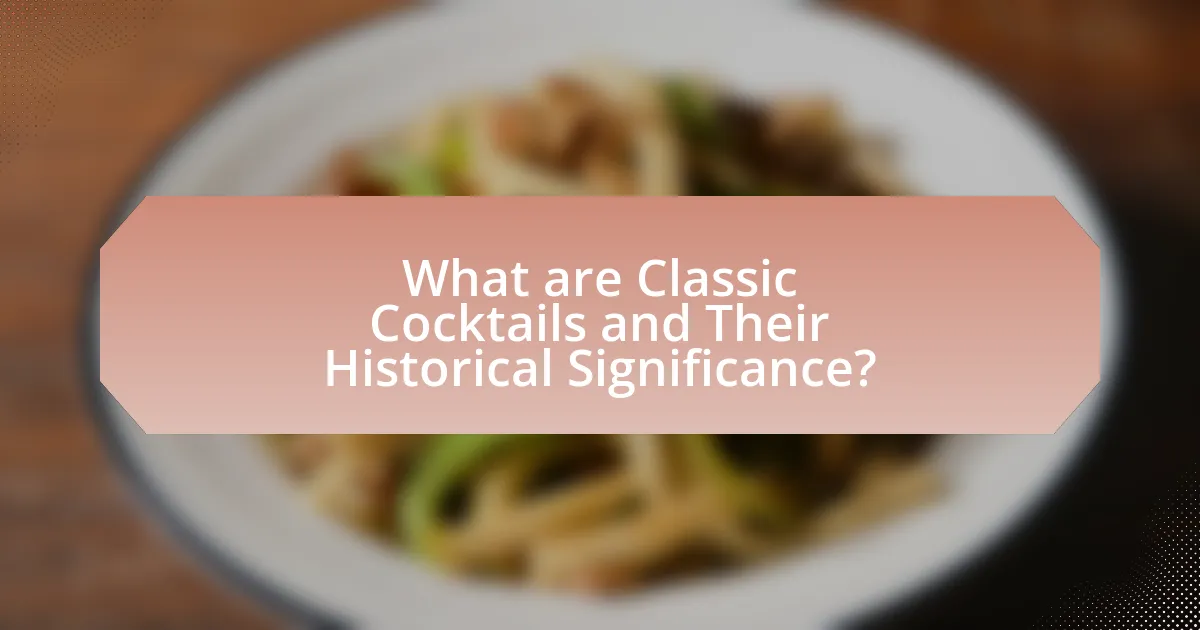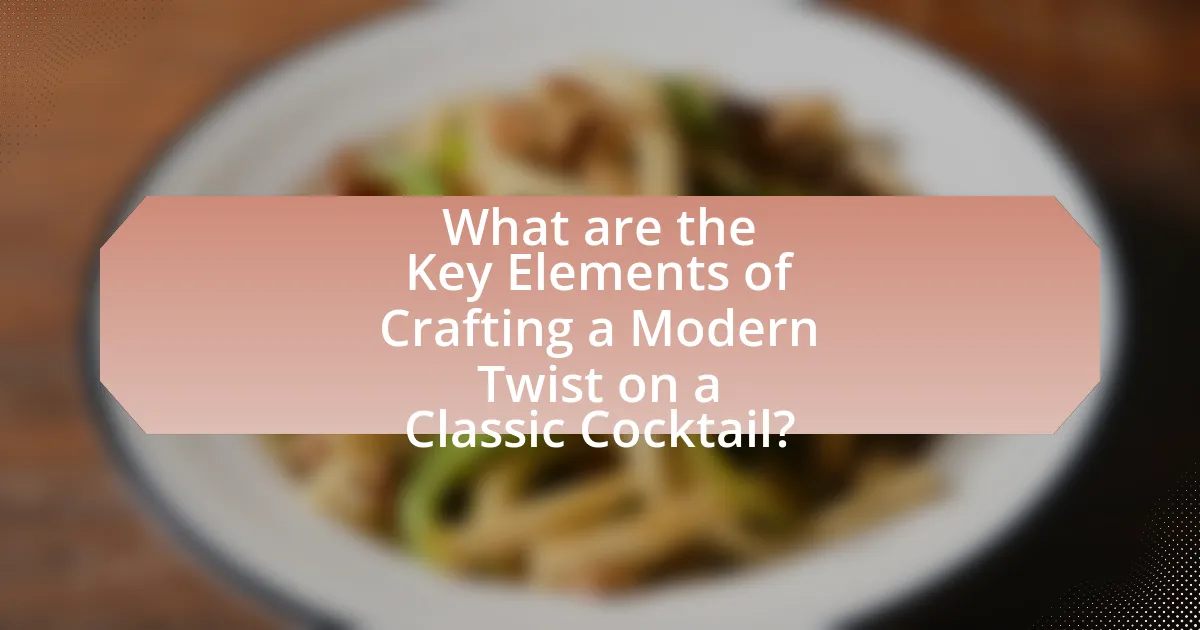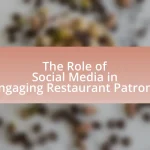Classic cocktails are traditional mixed drinks that have significantly influenced social drinking culture and modern mixology, with origins tracing back to the 19th and early 20th centuries. This article explores the historical significance of classic cocktails, their cultural influences, and foundational examples such as the Martini, Old Fashioned, and Manhattan. It also examines the reasons for their enduring popularity, the role they play in contemporary drinking culture, and how bartenders are reinterpreting these classics through innovative ingredients and techniques. Additionally, the article highlights the importance of creativity and experimentation in cocktail making, providing insights into crafting modern twists on timeless favorites while maintaining flavor balance and presentation.

What are Classic Cocktails and Their Historical Significance?
Classic cocktails are defined as traditional mixed drinks that have stood the test of time, often originating in the 19th and early 20th centuries, such as the Martini, Old Fashioned, and Manhattan. Their historical significance lies in their role in shaping social drinking culture, reflecting societal trends, and influencing modern mixology practices. For instance, the publication of “The Bartender’s Guide” by Jerry Thomas in 1862 helped standardize cocktail recipes, marking a pivotal moment in cocktail history. Additionally, classic cocktails often embody the craftsmanship and artistry of bartending, serving as a foundation for contemporary variations and innovations in the cocktail scene.
How did classic cocktails originate?
Classic cocktails originated in the early 19th century as a result of the evolving drinking culture in the United States, particularly during the period of the American Revolution and the subsequent rise of bars and saloons. The term “cocktail” was first defined in 1806 in a publication called “The Balance and Columbian Repository,” which described it as a mixture of spirits, sugar, water, and bitters. This foundational definition laid the groundwork for the development of various classic cocktails, such as the Old Fashioned and the Manhattan, which emerged as bartenders began to experiment with different ingredients and techniques. The establishment of cocktail culture was further influenced by the publication of cocktail recipe books, such as Jerry Thomas’s “The Bartender’s Guide” in 1862, which helped standardize and popularize these mixed drinks.
What cultural influences shaped the development of classic cocktails?
Cultural influences that shaped the development of classic cocktails include European traditions, particularly from France and Italy, as well as American innovation during the Prohibition era. The French and Italian contributions introduced techniques and ingredients such as vermouth and bitters, which became essential in cocktail crafting. American bartenders, facing restrictions during Prohibition, adapted these influences by creating new recipes that emphasized creativity and resourcefulness, leading to the emergence of iconic cocktails like the Martini and the Manhattan. This blend of European sophistication and American ingenuity established a foundation for classic cocktails that continues to influence modern mixology.
Which classic cocktails are considered foundational in cocktail history?
Classic cocktails considered foundational in cocktail history include the Martini, Old Fashioned, Manhattan, Daiquiri, and Negroni. The Martini, with its origins dating back to the mid-19th century, is often regarded as the quintessential cocktail, symbolizing sophistication. The Old Fashioned, created in the early 1800s, is recognized as one of the first cocktails, emphasizing the simplicity of spirits, sugar, and bitters. The Manhattan, developed in the 1870s, showcases the combination of whiskey, sweet vermouth, and bitters, reflecting the cocktail culture of New York City. The Daiquiri, originating from Cuba in the early 20th century, highlights the use of rum, lime, and sugar, while the Negroni, created in Florence in the early 20th century, combines gin, vermouth, and Campari, representing the Italian aperitivo tradition. Each of these cocktails has significantly influenced the development of modern mixology and remains a staple in bars worldwide.
Why are classic cocktails still popular today?
Classic cocktails remain popular today due to their timeless appeal and the resurgence of craft cocktail culture. The historical significance of these drinks, such as the Martini and Old Fashioned, contributes to their enduring status, as they are often associated with sophistication and tradition. Additionally, the craft cocktail movement, which emphasizes quality ingredients and artisanal techniques, has revitalized interest in these classic recipes, leading to their adaptation and reinterpretation in modern bars. This blend of nostalgia and innovation keeps classic cocktails relevant in contemporary drinking culture.
What role do classic cocktails play in modern drinking culture?
Classic cocktails serve as a foundational element in modern drinking culture, embodying tradition while inspiring contemporary mixology. Their enduring popularity is evidenced by the resurgence of speakeasy-style bars and craft cocktail movements, which emphasize quality ingredients and classic techniques. For instance, drinks like the Old Fashioned and Martini have seen a revival, with bartenders often experimenting with variations that respect the original recipes while introducing innovative flavors. This blend of nostalgia and creativity highlights how classic cocktails not only preserve historical drinking practices but also adapt to current tastes, reinforcing their significance in today’s social and culinary landscapes.
How do classic cocktails reflect societal trends and changes?
Classic cocktails reflect societal trends and changes by embodying the cultural, economic, and social dynamics of their respective eras. For instance, the Prohibition era in the United States led to the creation of cocktails that masked the taste of poorly made spirits, such as the Bee’s Knees, which combined gin with honey and lemon to improve flavor. This adaptation illustrates how societal restrictions influenced drinking habits and cocktail innovation. Additionally, the resurgence of classic cocktails in recent years aligns with a broader trend toward artisanal and craft movements, emphasizing quality ingredients and traditional techniques, as seen in the revival of drinks like the Old Fashioned and Negroni. This shift indicates a societal preference for authenticity and craftsmanship in food and beverage choices.

What are Modern Twists on Classic Cocktails?
Modern twists on classic cocktails are innovative variations that incorporate contemporary ingredients, techniques, or flavor profiles while maintaining the essence of the original drink. For example, a traditional Old Fashioned may be reimagined with the addition of smoked bitters or infused spirits, enhancing its complexity. Similarly, a classic Margarita can be modernized by using fresh fruit purees or unique liqueurs, such as mezcal, to introduce new dimensions of flavor. These adaptations reflect current trends in mixology, where bartenders experiment with local ingredients and creative presentations, thereby revitalizing timeless favorites for today’s palate.
How have bartenders reinterpreted classic cocktails?
Bartenders have reinterpreted classic cocktails by incorporating innovative ingredients, techniques, and presentation styles. For example, the traditional Old Fashioned has been modernized with the use of flavored bitters and artisanal ice, enhancing its complexity and visual appeal. Additionally, bartenders often experiment with molecular gastronomy, creating cocktails that feature foams or gels, which transform the drinking experience. This evolution reflects a broader trend in the cocktail industry where creativity and personalization are prioritized, allowing for unique interpretations that maintain the essence of the original recipes while appealing to contemporary tastes.
What innovative ingredients are being used in modern twists?
Modern twists on classic cocktails often incorporate innovative ingredients such as infused spirits, exotic bitters, and unique garnishes. Infused spirits, like jalapeño-infused tequila or lavender-infused gin, enhance traditional flavors with new dimensions. Exotic bitters, such as chocolate or celery bitters, add complexity and depth to cocktails. Unique garnishes, including edible flowers or flavored foams, not only elevate presentation but also introduce unexpected flavor profiles. These ingredients reflect a trend towards creativity and experimentation in cocktail crafting, as seen in contemporary mixology practices.
How do modern techniques enhance the classic cocktail experience?
Modern techniques enhance the classic cocktail experience by incorporating advanced methods such as molecular mixology, precision temperature control, and innovative infusion techniques. These methods allow bartenders to create unique textures, flavors, and presentations that elevate traditional recipes. For example, molecular mixology employs tools like foams and gels to transform the sensory experience of cocktails, while sous-vide infusion allows for precise flavor extraction from ingredients, resulting in more vibrant and complex drinks. This evolution not only preserves the essence of classic cocktails but also introduces new dimensions, making the drinking experience more engaging and memorable.
Why is creativity important in cocktail making?
Creativity is important in cocktail making because it allows bartenders to innovate and enhance traditional recipes, resulting in unique flavor profiles and experiences. This innovation is essential for attracting customers in a competitive market, as creative cocktails can differentiate a bar’s offerings. For instance, the rise of craft cocktails has led to a 20% increase in sales for establishments that prioritize unique drink creations, according to industry reports. Additionally, creativity fosters experimentation with ingredients, techniques, and presentation, which can elevate the overall dining experience and encourage customer loyalty.
How does experimentation lead to new cocktail trends?
Experimentation leads to new cocktail trends by allowing mixologists to explore innovative flavor combinations, techniques, and presentation styles. This creative process often results in unique drinks that capture consumer interest and reflect current culinary trends. For instance, the rise of molecular gastronomy in cocktail making has introduced elements like foams and gels, transforming traditional drinks into visually striking and texturally diverse experiences. Additionally, the use of locally sourced ingredients and artisanal spirits has become popular, driven by a desire for authenticity and sustainability in cocktail culture. These trends are often documented in industry reports, such as the “Cocktail Trends Report” by the Beverage Information Group, which highlights how experimentation shapes consumer preferences and influences bar menus.
What are some examples of successful modern twists on classics?
Successful modern twists on classic cocktails include the Espresso Martini, which combines vodka, coffee liqueur, and fresh espresso, revitalizing the traditional martini concept with a caffeine kick. Another example is the Smoked Old Fashioned, where the classic Old Fashioned is enhanced with smoked wood flavors, adding depth to the original whiskey-based drink. The Mezcal Margarita replaces tequila with mezcal, introducing a smoky flavor profile while maintaining the essence of the classic margarita. These adaptations showcase creativity while honoring the foundational elements of the original cocktails.

What are the Key Elements of Crafting a Modern Twist on a Classic Cocktail?
The key elements of crafting a modern twist on a classic cocktail include ingredient innovation, presentation enhancement, and flavor balance. Ingredient innovation involves substituting traditional components with contemporary alternatives, such as using craft spirits or unique mixers to create new flavor profiles. Presentation enhancement focuses on visually appealing garnishes and glassware that elevate the drinking experience. Flavor balance ensures that the cocktail maintains harmony between sweetness, acidity, and bitterness, often achieved through the use of fresh herbs, spices, or artisanal syrups. These elements collectively contribute to a cocktail that respects its classic roots while offering a fresh and exciting experience for modern palates.
How do flavor profiles influence cocktail creation?
Flavor profiles significantly influence cocktail creation by guiding the selection of ingredients that complement or contrast with each other. For instance, a cocktail’s flavor profile can be categorized into sweet, sour, bitter, and umami, which helps mixologists balance these elements to achieve a harmonious drink. Research indicates that the balance of these flavors can enhance the overall sensory experience, as seen in classic cocktails like the Margarita, which combines the sweetness of agave with the acidity of lime. This balance is crucial for creating modern twists on timeless favorites, as it allows bartenders to innovate while respecting traditional flavor combinations.
What are the essential components of balancing flavors in cocktails?
The essential components of balancing flavors in cocktails are sweetness, acidity, bitterness, and dilution. Sweetness, often derived from syrups or liqueurs, counteracts acidity and bitterness, creating a harmonious flavor profile. Acidity, typically from citrus juices, adds brightness and freshness, while bitterness, introduced through ingredients like bitters or herbal liqueurs, provides depth and complexity. Dilution, achieved through ice melting during shaking or stirring, helps to mellow strong flavors and integrate the components. These elements work together to create a well-rounded cocktail, as evidenced by classic recipes that have stood the test of time, such as the balance found in a well-crafted Daiquiri or Negroni.
How can seasonal ingredients enhance classic cocktails?
Seasonal ingredients can enhance classic cocktails by introducing fresh flavors and aromas that reflect the time of year, thereby elevating the overall drinking experience. For instance, using ripe summer fruits like peaches or berries can add natural sweetness and vibrant color to traditional drinks such as the Mojito or Daiquiri. Additionally, seasonal herbs like basil or mint can provide aromatic complexity, making cocktails more refreshing and appealing. Research indicates that incorporating local and seasonal produce not only supports sustainable practices but also aligns with consumer preferences for freshness and quality, as highlighted in studies by the Culinary Institute of America.
What techniques can be employed to create a modern twist?
To create a modern twist on classic cocktails, bartenders can employ techniques such as ingredient substitution, innovative presentation, and the use of modern mixology tools. Ingredient substitution involves replacing traditional components with contemporary flavors or spirits, enhancing the drink’s profile while maintaining its essence. Innovative presentation can include unique glassware, garnishes, or serving methods that elevate the visual appeal and experience. The use of modern mixology tools, such as sous-vide for infusions or molecular gastronomy techniques, allows for new textures and flavors, further transforming classic recipes into modern interpretations. These techniques have been widely adopted in the cocktail industry, reflecting a trend towards creativity and personalization in beverage preparation.
How does presentation impact the perception of a cocktail?
Presentation significantly impacts the perception of a cocktail by influencing the drinker’s expectations and enjoyment. A visually appealing cocktail can enhance the perceived quality and flavor, as studies show that aesthetics play a crucial role in taste perception. For instance, research published in the journal “Food Quality and Preference” indicates that people often associate vibrant colors and intricate garnishes with higher quality, leading to a more favorable overall experience. Thus, the way a cocktail is presented can alter not only its perceived taste but also the drinker’s emotional response, making presentation a vital aspect of cocktail culture.
What tools and equipment are essential for crafting modern cocktails?
Essential tools and equipment for crafting modern cocktails include a cocktail shaker, jigger, bar spoon, muddler, strainer, and a variety of glassware. The cocktail shaker allows for effective mixing and chilling of ingredients, while the jigger ensures precise measurement of spirits and mixers, which is crucial for balance in cocktails. A bar spoon is used for stirring and layering drinks, and a muddler helps to extract flavors from herbs and fruits. A strainer is necessary to separate solids from liquids when pouring cocktails, and different types of glassware enhance the presentation and experience of the drink. These tools are fundamental in both home and professional settings, reflecting the importance of technique and presentation in modern mixology.
What are some tips for creating your own modern twists on classic cocktails?
To create modern twists on classic cocktails, start by experimenting with unique ingredients that enhance or contrast the original flavors. For example, using artisanal bitters or flavored syrups can add complexity to a traditional Old Fashioned. Additionally, consider altering the base spirit; substituting gin with a flavored vodka in a Martini can provide a fresh perspective. Incorporating seasonal fruits or herbs, such as basil or watermelon, can also modernize the drink while maintaining its essence. Finally, presentation matters; using unconventional glassware or garnishes can elevate the cocktail experience. These approaches are supported by the trend of craft cocktail culture, which emphasizes innovation while respecting classic techniques.
How can you experiment safely with flavors and ingredients?
To experiment safely with flavors and ingredients, start by understanding the basic flavor profiles and potential allergens of each ingredient. This foundational knowledge allows for informed combinations that enhance rather than clash. For instance, pairing citrus with herbal notes can create a balanced cocktail, while being aware of common allergens like nuts or gluten can prevent adverse reactions. Additionally, conducting small-scale tests before larger batches ensures that the flavors meld well without risking waste or safety. This method is supported by culinary practices that emphasize gradual experimentation, allowing for adjustments based on taste and safety.
What resources are available for learning more about cocktail mixing?
Books, online courses, and cocktail mixing apps are valuable resources for learning about cocktail mixing. Notable books include “The Joy of Mixology” by Gary Regan and “The Craft of the Cocktail” by Dale DeGroff, which provide foundational knowledge and techniques. Online platforms like MasterClass offer courses taught by renowned mixologists, while apps such as Cocktail Flow and Mixology provide interactive guides and recipes. These resources collectively enhance understanding and skills in cocktail preparation, supported by the expertise of established professionals in the field.


